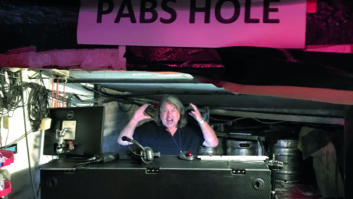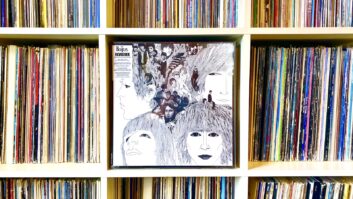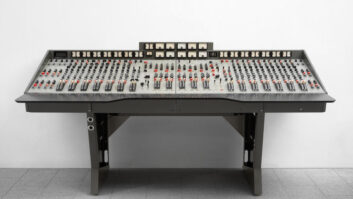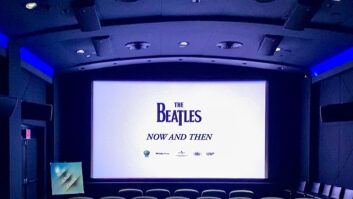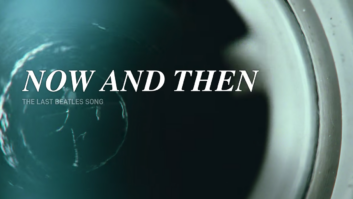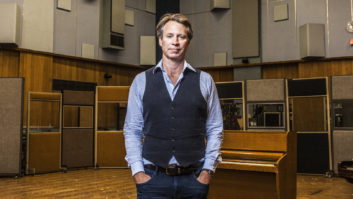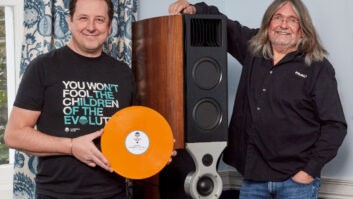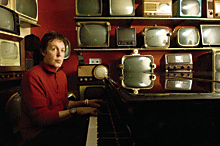

Few producers get a second round recording Paul McCartney; other than George Martin, that distinction belongs to David Kahne (Sugar Ray, Sublime, Kelly Clarkson). Kahne produced McCartney’s 2001 effort, Driving Rain, and a host of live recordings since then. Most recently, Kahne was at the helm for Memory Almost Full, the debut release from Starbucks’ Hear Music label.
McCartney, Kahne and the ex-Beatle’s touring band (guitarist Rusty Anderson, guitarist/bassist Brian Ray, drummer Abe Laboriel Jr. and keyboardist Paul “Wix” Wickens) did most of the tracking for Memory at McCartney’s The Mill home studio and at McCartney’s “old home,” EMI’s Abbey Road Studios No. 2. Additional recording and overdubbing took place at Henson Recording Studios in Los Angeles and the producer’s See Squared Studio in New York City.
Kahne engineered much of the project himself, as he did on Driving Rain, though some engineering at the Abbey Road sessions was handled by Beatles/McCartney veteran Geoff Emerick and by Paul Hicks (The Beatles’ Love). At The Mill, Kahne was assisted by either Adam Noble or Steve Orchard, and elsewhere by Keith Bolster and Kevin Mills. The producer records to a custom PC running Steinberg Cubase Studio 4. His particular gear preferences include Violet Design microphones, Roger Nichols Digital plug-ins, and Fairchild 670 and Federal AM-864 tube compressor/limiters. “The Federals are older than the Fairchilds,” Kahne notes. “Mine are old Army gear — they say ‘Signal Corps.’ on them!”
Kahne says that the process for recording McCartney changes, of course, depending on the track and on whether Kahne is recording McCartney with his band or alone. “On the work with the band, he’ll usually play it on an acoustic guitar and show everybody the song, and then work out the arrangement,” Kahne says. For solo recordings, “There is no ‘typical.’” However, Kahne notes that McCartney’s trademark melodic lines are ever present. “Paul always has lines going, which is great because I’ve always analyzed music that way. What’s going on with the bass line and the voice at any particular moment? It’s more of a classical approach. The arrangement is just a question of what is the part supposed to do, and then choosing the instrument, amp or whatever. That’s how I approach it, and it turns out that’s what he does, which is one reason why we get along.

“There’s an emotional journey to the whole record,” Kahne continues. “He’s made an amazing album, as good as anything he’s ever done. Listen to it over and over again.” Track by track, Kahne shares some of the moments from the journey he shared with McCartney in making Memory Almost Full.
“Dance Tonight”: “That kick drum sound you hear at the beginning and throughout the track is actually Paul stomping on a piece of wood with his foot,” Kahne recalls. The mandolin-based track was recorded in January 2007 at RAK Studios in London. It was the last song recorded for the album and features McCartney on mandolin (an instrument he mastered for this recording), bass, auto-harp, drums, fuzz bass, keyboard and electric guitar.
“Ever Present Past”: Although it sounds like electronica, this track is all McCartney on real instruments, though heavily processed. “He showed it to me on piano, and then we started recording with electric guitar, recorded to a drum loop, and then he put down a work vocal and then he recorded his drums,” Kahne recalls.
McCartney played his Epiphone Casino, first heard in 1965 on The Beatles’ “The Night Before.” Kahne says he plays it through a Vox AC30, the same type the Fab Four used in the ’60s, although McCartney’s current amp is a reissue. The bass is his famous Hofner, and the drums are McCartney’s black Ludwig kit, similar to Ringo Starr’s in that the two, both left-handers, play right-handed kits. The song also features harpsichord and flugelhorn by McCartney — the latter heard as a solid note through the pre-chorus.
“See Your Sunshine”: Kahne says this track features “Paul playing bass at his absolute best. There was a bass fix that we needed to do, right before the bridge, which I asked him to do. He played it and was just goofing around — he was playing all over the place, like only he can play; just amazing stuff. So I asked him, ‘Can you play from the beginning of the song the same way?’ And he goes, ‘Sure,’ which he did. When we were done, I said, ‘Well, that could be the bass part,’ and he said, ‘I don’t know…’ He thought it was too busy, but after he listened to it, he said, ‘That’s really cool.’”
The two also spent a good amount of time on drums. “We just kept doing more and more drums and loops,” Kahne says, “just getting the groove right and the tempo. We gave it several tempo changes.” A few hours’ work also generated the song’s wonderfully soulful background vocals. “It’s a voicing of the piano part, so it’s really an orchestration rather than a brand-new part.”

Producer David Kahne also engineered much of Memory Almost Full.
Photo: Matt Hurwitz
“Only Mama Knows”: The first Abbey Road band track heard on the album, this song was recorded live. As was the case whenever McCartney played guitar or piano during tracking, bandmember Brian Ray played bass and McCartney would later replace that part. “Paul’s a good bass player,” Kahne winks. The rocker opens with a sad string section — actually, a complement of samples, Mellotron and live strings.
“You Tell Me”: “‘You Tell Me’ is maybe the saddest song he’s ever written,” Kahne says. McCartney wrote the song in Long Island, and is, as he describes, “a tribute to golden summers.” The mostly acoustic number opens with some forward and backward organ, along with Laboriel playing a drum pad triggering some drum samples. McCartney’s vocal was recorded in a single pass, joined by beautiful vocals from the bandmembers.The backward/forward organ, used to create a mood, is followed by a quiet count-in from McCartney. “I was really happy he let me include the count-in. It’s iconic.”
“Mr. Bellamy”: This track is about a fellow who climbed up a building and won’t come down. Recorded in March of ’06 at The Mill, it is one of four songs that were tracked that day. Instrumentation-wise, McCartney built the song following the lyrics. McCartney sang two vocal lines during the song’s second bridge, a favorite of Kahne’s. “The vocal from the first ‘B’ section comes in halfway through, and it really makes a good counterpoint vocal,” Kahne recalls. “Concert-quality double melody, and you can hear them both very clearly. They cross each other, but you can still hear them.”
For drums during the song’s “B” sections, McCartney chose to play his kick in an unusual manner. “He wanted this kick pattern that was real quick. He was thinking it, but he couldn’t get his foot to do it the right way. So he jumped off the drum kit and undid the beater of the bass drum, and he got on his knees and played it by hand.” The drums are played normally during the rest of the song, creating a dynamic contrast.
One other detail was kept in from the original session: “We were recording, and there was a guy there doing a photo shoot, taking some pictures. You can actually hear his shutter snap on the song, which I left in the intro because the guy in the song is sort of in that situation, which fit.”
“Gratitude”: Another soul song recorded the same day as “Ever Present Past,” this track features McCartney on piano, bass and drums, live orchestra, horn samples (on the bridge) and loads of background vocals. Kahne says of McCartney’s performance on the track, “He really sings his heart.”
“Medley”: The latter half of the album is made up mostly of a five-song medley, McCartney’s first since his “Little Lamb Dragonfly” medley on the 1973 Red Rose Speedway. “He said one day that it was the only song he ever wrote the words to first, except for ‘All My Loving,’” Kahne says.
Basic track recording for those five songs, which were recorded separately, was done with the band at Abbey Road, though overdubbing continued for long after at The Mill, Henson and at Kahne’s studio in New York City. Transitions between songs were recorded either during tracking of a song or as a pickup later.
“Vintage Clothes,” with its unusual tempo changes, features McCartney on piano and acoustic guitar, with Anderson playing electric. “I like some of the electric guitar sounds because it’s evocative of some of the sounds they achieved at Abbey Road like on the ‘Sgt. Pepper’ reprise,” Kahne notes. Background vocals are, as Kahne puts it, “stacks of Paul.” McCartney’s Mellotron — captured from Abbey Road long ago — is the same one featured doing the “flute” opening on “Strawberry Fields Forever,” and he is, in fact, playing that very setting on this recording.
“That Was Me”: The very Ram-like “That Was Me” again features McCartney and the band, mostly on acoustic guitars. During the third verse, after the guitar solo, McCartney added a little something extra. “We were talking about that part needing a lift, and he said, ‘Well, maybe I’ll sing it up an octave,’ doubling the guitar line. He went out, and that’s the second pass. He kind of figured it out and just ripped it.”
“Feet in the Clouds”: On the third “Medley” track, most of the original band tracking was replaced early in 2007, with the exception of Anderson’s guitar line and the group backing vocals. McCartney’s vocal in one section was treated to Celemony Melodyne Studio signal processing software. “I had about 36 tracks of vocals,” Kahne says. “I chose different lines to flatten out to get rid of the vibrato. Then in the mix, I kind of pitched them a little bit, which took a fairly long time. Melodyne does what Auto-Tune does, but better.”
“House of Wax”: The climactic “House of Wax,” which McCartney played live on his handful of “secret gig” shows supporting the album, again features the band, with McCartney providing the crying blues guitar solo. “The solos were a big deal for me,” Kahne recalls. “Those sections were blank; we didn’t know what we were going to put there. I heard ‘Taxman’ on the radio, for which he’d done the solo, and I thought how great it would be if he would just rip in those big breaks. So I asked, ‘Instead of making a more complex part, can you just play guitar solos?’ He said, ‘Okay,’ sat in the control room with his Casino plugged into the Vox and just whipped it up, and literally, a half-hour later, they were done. I’ve never heard him play guitar like that. He just pushes the notes sharp perfectly at the right time.”
“End of the End”: McCartney sings about what he’d like to see one day at his funeral. He is playing the “Mrs. Mills piano,” as it is known at Abbey Road — the same one used on “Lady Madonna” 35 years earlier. “He did quite a few takes, and he was wearing headphones,” Kahne says, “when he suddenly realized, ‘Oh, wait, I don’t need to wear headphones,’ because he was singing and playing live. So he took them off, and then it had a different sort of feel to it.” The song also features a double quartet of strings.
“Nod Your Head”: Though the recording sounds like a band, it’s all McCartney. The recording started on piano, followed by drums, and then bass and guitars. The drums featured a Violet Design Flamingo mic capturing room sound, which was compressed. “I just crushed it and kept moving it around until I was getting the air I wanted in a room mic while he was warming up. And that sound has a lot to do with the sound of the mic,” Kahne says. “Also, the take wasn’t coming together, and we redid it, and did it, and did it, and it wasn’t working. It got a little tense, and then the next take he got it. But he started goofing around, and he started yelling while he was playing, and that yelling is still a really cool part of the song.”
LISTEN:
Dance Tonight
LISTEN:
Ever Present Past
WATCH:
Memory Almost Full Video

